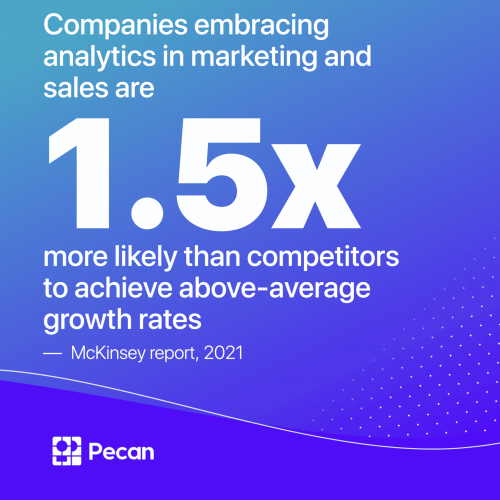In a recent Gartner report, roughly 90% of marketing executives agreed that “the marketing function needs to be ‘more adaptive to shifts in customer needs.’” But sometimes, the marketing team sits miles away from the customer. They aren’t able to understand the customer’s needs or make shifts that are truly adaptive.
Of course, this dilemma has been one of the strongest arguments for data-driven marketing. It’s also a key reason to integrate advanced analytics for customer experience (CX) programs. As MarTech says, data allows marketers to personalize and optimize the customer journey, helping drive conversions and improving customer retention.
Today, a human touch is a mandatory part of customer experience management. But the human touch must be combined with a data-informed perspective and strategy. To accomplish that, you can leverage advanced analytics for the modern customer experience powered by AI and machine learning. When you know more about customers, you can provide them with what they need and want as they interact with your brand.
Let’s explore some recent studies that illustrate the importance of a data-driven culture. These research findings also show how marketers, CX leaders, and cross-functional teams can create a roadmap for advanced analytics within their organizations.
Why a data-driven culture is crucial for modern CX
For B2B and B2C companies, data is vital to the growth and success of the business. McKinsey found that companies embracing analytics in marketing and sales were 1.5x more likely than their competitors to experience above-average growth rates.
In addition to the performance increase and the net new profits realized, there are other reasons to embrace analytics.
For starters, advanced analytics lets you better plan your use of resources. In a recent case study by Pecan AI, an auto insurance company reduced overstaffing by as much as 20%. In addition to improving the bottom line, the company also reduced customer wait times. Their data-driven approach provided better customer service and more positive customer interactions.
Last but not least, advanced analytics will help increase customer lifetime value and extend your relationship with your customers.
Recently, Pecan AI worked with a gaming company to predict top prospects for promotions of exclusive offers and incentives. The results were amazing! Using the predictions reduced churn by 50%, making a real impact on customer loyalty. In addition, the gaming company saw customer spending increase by a whopping 350% per user.
How can CX leaders and marketers get started with advanced analytics?
Advanced CX analytics starts with knowing what approach is right for you and your organization. If you’re unsure about the right direction for you and your team, here’s a helpful guide to getting started.
Then, when you’re ready to pilot an advanced analytics framework within your marketing and customer experience organization, start with a narrow focus. That specific focus will keep your analysis of customer data and, ultimately, your predictions targeted toward solving a particular problem.
Pecan AI has created a number of off-the-shelf advanced analytics/predictive models. Brands can use this accessible platform to get closer to the customer, boost customer engagement and customer satisfaction, and drive business value. Pecan’s automated approach means you can start with AI today and see predictions in weeks.
Exploring advanced analytics for customer experience and satisfaction
You’ll need to carefully evaluate the right questions to explore first. For example, the goal of your pilot might be to get closer to the customer. In that case, predicting customer churn and upsell/cross-sell opportunities are great ways to get started.
By predicting which customers are about to churn, CX teams can proactively explore the drivers that led a customer to churn. Similarly, you can see which factors make customers more or less likely to upgrade their service with you or purchase complementary products and services. This information is also an important reason to choose an explainable AI solution that offers accurate predictive insights.
Once you know the drivers of customers’ behavior, you can make data-guided decisions. You can then explore product updates, identify pain points, make changes to support and service SLAs, or create productive marketing communications. You’ll be far better informed and able to shape strategies to keep customers happy and improve customer experiences.
No matter which business problems you tackle first, there’s no doubt that advanced analytics will be a game changer for your business. Generating predictions of future customer behavior will help your team be adaptive to their needs. In addition, it’ll empower your team to offer proactive support for what customers are likely to need in the future.
We’re here to help you and your marketing team take the next steps toward AI adoption. Get in touch for a quick, easy use-case consultation.




